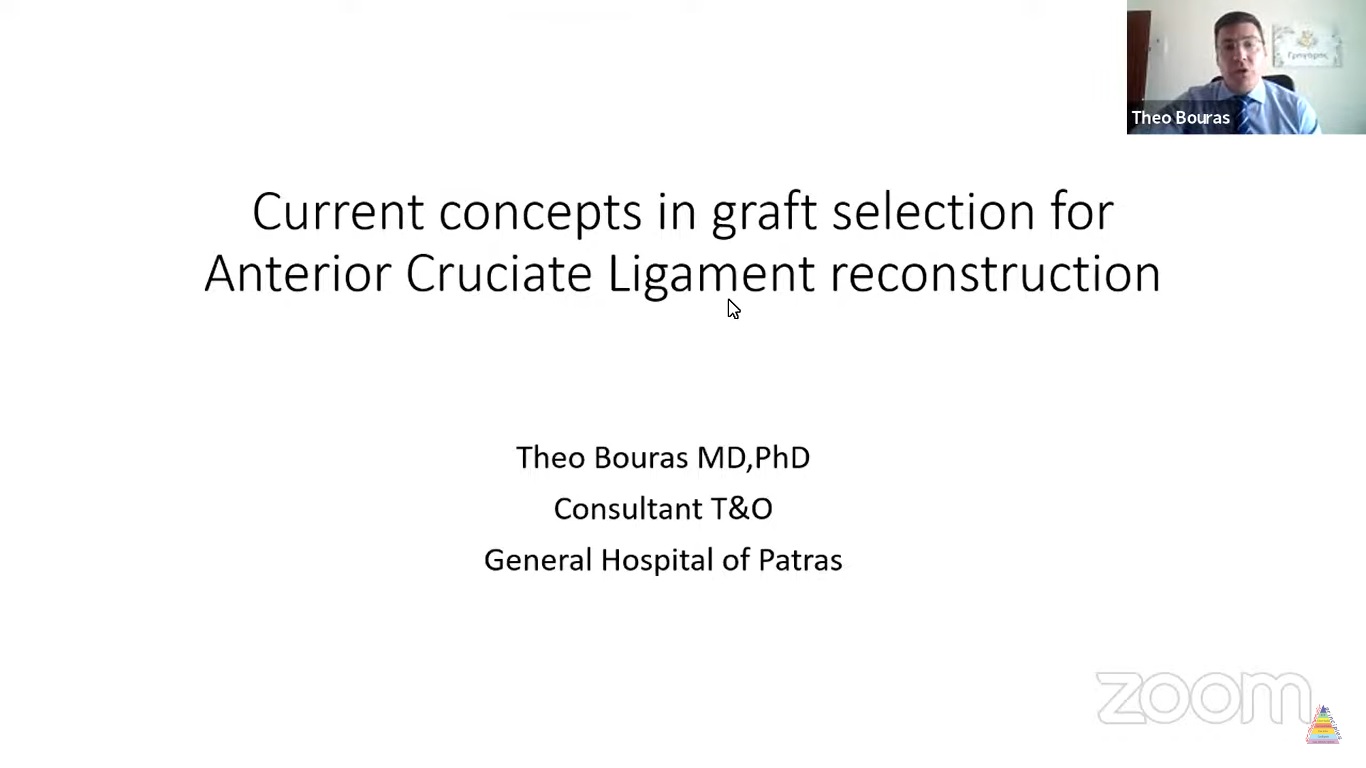Courtesy: Theo Bouras MD, PhD, Patras, Greece
Graft selection in ACL reconstruction
The ACL ligament is the main stabilizer for the anterior translation of the tibia. It also contributes in rotational stability along with medial meniscus. It consists 90 percent of collagen type 1, 10 percent of collagen type 3, has 2 bundles the anteromedial which tensions in flexion and posterolateral tensions in extension. The mean length of ligament is 30 to 35 mm, and mean diameter is about 11mm.
Histology
There are 4 transition zones. They are tendon, unmineralized fibrocartilage, mineralised fibrocartilage (Sharpie fibres) and bone.
History
Galen of Pergamon(131-201BC) gave the names, in 1836 the German scientists Wilhem (1806-1871) and Eduard Weber 1804-1891) anatomically described the two ACL bundles. The first ACL repair was performed by Mayo- Robson of Leeds in 1895. Gerkow and Hey Groves initiated ACL reconstruction with autologous tissue (using ITB band) between 1914 and 1920.
Types of grafts:
The two main categories of grafts include autografts and allografts. Autografts include hamstrings tendon, bone- patellar bone- bone(BTB), quadriceps tendon autograft (with or without bone block). Allografts include BTB composites, Achilles tendon, tibialis anterior, tibialis posterior, hamstring, and the synthetic grafts.
Autografts
Advantages of autografts include, healing more quickly with long term viability, they are not involved in disease transmission or initiation of host’s immunity, inexpensive method, no special instruments are required for preservation, have lower failure and infection rates, and have fewer ethical and religious concerns. Disadvantages on the other hand include limited availability, increased operative time, donor site morbidity and functional impairment.
Hamstring muscles autograft
Advantages of hamstring muscles graft include reproducibility of the technique, small incisions, autologous tissue, no anterior knee pain, options to graft sizing and a maximum load to failure of 4500N. The disadvantages of the same include unpredictable graft size, saphenous nerve injury, residual hamstring weakness and windshield wiper effect.
BTB autografts
It is considered as the gold standard technique for ACL reconstruction. The advantages include autologous tissue, bone to bone healing, maximum load to failure of 2600N, no windshield wiper effect and no residual hamstring weakness. The disadvantages of the same include anterior knee pain, patella fracture, patella tendon rupture and tunnel mismatch.
Quadriceps tendon autograft
These are increasingly becoming popular. The advantage is that these are versatile graft (half/full thickness+/- bone block), minimally invasive technique, reduce graft size variation, these are autologous tissue, better biochemical properties than BTB. The disadvantages include donor site morbidity, steep learning curve, quadriceps weakness, patella fracture, lack of robust evidence.
Allografts
Allografts on the other hand have no donor site morbidity, less postoperative and long term pain, decreased operative time, better cosmetic appearance with no functional impairment and have a large variety of graft sizes and shapes. The disadvantages include expensive method, disease transmission, healing concerns, unclear long term viability, chances of immune rejection, lack of availability, ethical and religious concerns.
- The main indications of allograft use include patients older than 40 years, multiple ligament knee injuries, prior harvest from donor sites, patient preference, revision ACL-reconstruction.
- The treatment of the graft could be either by irradiation or by non irrradiation using chlorhexidine or supercritical co2, deep or fresh frozen technique ( which have better results). Allografts have produced better results in practice however the failure rates are high in younger patients.
Synthetic/ Artificial grafts
The early use of synthetic graft did not produce better results and resulted in increased wear and tear, synovitis and failures, and resulted in discarding of these synthetic grafts. However new 3rd generation artificial grafts such as Ligament Advanced Reinforcement System (LARS), Gore-Tex, Leeds-Keio have evolved which showed comparable results with autografts in various studies

Leave a Reply